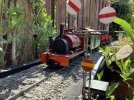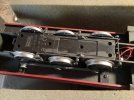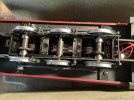playmofire
Registered
The main loco the SHA (Seaport Harbour Authority) railway use is an LGB Spremberger tank engine, but I have been on the lookout for an 0-6-0, either an LGB BR80 or one of the Piko USA tank locos. A pair of the latter cropped up in a Vectis auction recently and I left a bid of £130 for the pair, not expecting to win them, the idea being to keep one and sell the other. Here's a link:
 www.vectis.co.uk
www.vectis.co.uk
I collected them yesterday when I went to drop some stuff for auction and as you can see, the skates suggest little use (photo 1), as does the general condition. Running them, they both ran straight away, forward and reverse, but with a tendency to stall on R1 points, especially at slow speeds; the faster they go, the less the chance of stalling. This surprised me with the 0-6-0 layout, as even the Spremberger and Playmobil 0-4-0 locos generally cope OK with R1 points without stalling.
Then, I searched on GSC for Piko 0-6-0 tank, and discovered maybe why there was so little interest in them at the auction! Those black wheels were powder coated, hence insulated, although Pijko addressed the problem later on. Tests show that there appears to be no current pickup from either the front or rear sets of wheels, even though a peer inside suggests there should be (see photo 2). There was light grease which I distributed more over the teeth of the gears than down the sides (although, after a test run, it was more down the sides than on the teeth again!), which seemed to help a bit towards smoother running over the points.
The embossing on the loco underside says made in Germany with the date on the casting of 2008.
I took a cottonwool bud with a a bit of cellulose thinners on to one of the wheel treads on one of the locos, and this came off black, revealing a slightly shiny, metal surface underneath, so maybe a good clean might cause electricity to flow.
So any comments on the problem/solution would be appreciated.
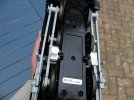
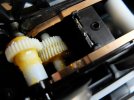
Vectis Auctions | Upcoming
View the listings catalogue, register to bid and find out where and when our next auctions are with our online auction calendar.
I collected them yesterday when I went to drop some stuff for auction and as you can see, the skates suggest little use (photo 1), as does the general condition. Running them, they both ran straight away, forward and reverse, but with a tendency to stall on R1 points, especially at slow speeds; the faster they go, the less the chance of stalling. This surprised me with the 0-6-0 layout, as even the Spremberger and Playmobil 0-4-0 locos generally cope OK with R1 points without stalling.
Then, I searched on GSC for Piko 0-6-0 tank, and discovered maybe why there was so little interest in them at the auction! Those black wheels were powder coated, hence insulated, although Pijko addressed the problem later on. Tests show that there appears to be no current pickup from either the front or rear sets of wheels, even though a peer inside suggests there should be (see photo 2). There was light grease which I distributed more over the teeth of the gears than down the sides (although, after a test run, it was more down the sides than on the teeth again!), which seemed to help a bit towards smoother running over the points.
The embossing on the loco underside says made in Germany with the date on the casting of 2008.
I took a cottonwool bud with a a bit of cellulose thinners on to one of the wheel treads on one of the locos, and this came off black, revealing a slightly shiny, metal surface underneath, so maybe a good clean might cause electricity to flow.
So any comments on the problem/solution would be appreciated.



